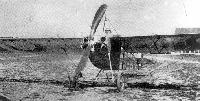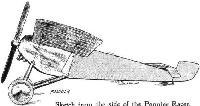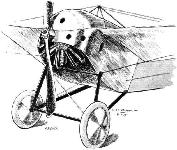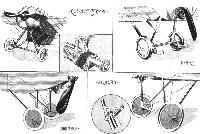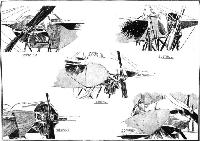J.Davilla, A.Soltan French Aircraft of the First World War (Flying Machines)
Avions Ponnier
In 1915 louis Alfred Ponnier built a racing monoplane that placed second in the Coupe Internationale at Reims. Other designs included the L.1 Eclareur with an 80-hp engine; a touring monoplane with an 80-hp Le Rhone; a two-seat monoplane with an 80-hp engine: a biplane with a 50-hp Gnome, and a racer with a 160-hp Gnome. The racing aircraft, designated the D.5. was flown by Jules Vedrines; it finished second in the Gordon-Bennett Cup Race ol 1915.
Показать полностью
L.Opdyke French Aeroplanes Before the Great War (Schiffer)
Deleted by request of (c)Schiffer Publishing
Even more famous than the D.I, the D.III was flown in the Gordon-Bennett race at Reims, also in 1913, by Vedrines; his machine was marked F5.
(Span: 7 m; length; 5.5 m; wing area: 8 sqm; loaded weight: 500 kg; speed: 200 kmh; 160 hp Gnome)
In the same year a variant was designated Type Cavalrie, with divided elevators as opposed to the one-piece set of the DIII.
(Span: 9.2 m; length: 5.26 m; wing area: 13 sqm; weight empty: 215 kg; weight loaded: 375 kg; speed: from 60 to 135 kmh)
Ponnier also built a small 2-seater trainer, Type Ecole, in 1914. It had a 3-cylinder engine and an uncovered fuselage supported by a 4-legged undercarriage. In July 1914 the firm offered the LI, also a Type Cavalrie, a small single-seater biplane with a 50 hp Gnome.
(Span: 8 m, 7.2 m; length: 5.5 m; wing area: 20 sqm; weight empty: 260 kg)
Показать полностью
Журнал Flight
Flight, November 22, 1913.
THE PONNIER MONOPLANE.
ALTHOUGH the Ponnier monoplane did not succeed in winning the Gordon-Bennett race it is none the less interesting, for it is probably as fast as the winner, and the difference in speed is accounted for by the fact that the pilot, M. E. Vedrines, did not cut his corners so sharply as did M. Prevost. In its general appearance the Ponnier follows the lines of its predecessor, the well-known Hanriot monoplane.
The fuselage, which is very deep and wide in the front portion, is of rectangular cross section, and is built up in the usual way of four longerons of ash connected by struts and cross members, the whole being made rigid by means of diagonal cross wiring. In the nose of the machine the longerons converge abruptly in an upward and downward direction to meet the front engine bearers. An aluminium shield covering in the greater part of the engine, and running back to form a wind screen in front of the pilot, prevents any oil from being blown back into the pilot's face. The landing chassis fitted to this machine is evidently meant for racing purposes only, for it has been reduced to the simplest possible form, and does not even provide any springing of the wheels, so that it would not be very suitable for landing on anything but the smoothest of surfaces. For the purpose for which it was designed, however, it was doubtless quite good, and, as our readers may be aware, the chassis usually fitted to these machines is of the wheel and skid type, which combination has proved very satisfactory.
The wings are of the standard Ponnier type with a Philip's entry, and a very pronounced wash out to the trailing edge. The spars are of rectangular section, hollowed out for lightness. The number of lift wires has been reduced to a minimum, there being only two wires - one top and one bottom - to each spar. The lower wires are not carried to the lower extremities of the chassis, which is the usual procedure, but have been secured to the lower longeron of the fuselage, the reason probably being, that should the chassis be damaged on landing the fuselage will have a chance to escape serious injury, while the lift wires will remain intact. The resultant angle of the lift wires does not appear any too good, but presumably the designers of the machine have such confidence in the strength of the internal wing construction that one lift wire to the under side of each spar has been deemed sufficient.
The power plant of this machine is the same as that of the Dep., i.e., a 160 h.p. Gnome engine driving directly an Integral propeller of 6 ft. 10 ins. diameter. Wholly on top of the rear portion of the fuselage is mounted a fixed tail plane which is of the flat, non-lifting type, to the trailing edge of which are hinged the elevators. A rudder projecting upwards above the body is hinged to the stern post of the fuselage. A tail skid of the simplest form, consisting of an elliptical leaf spring, protects the tail planes against contact with the ground.
Flight, December 13, 1913.
THE STANDS AT THE PARIS AERO SHOW.
PONNIER.
On the Ponnier stand are shown two monoplanes, which resemble in their general arrangement the one illustrated in the columns of FLIGHT a fortnight ago, which was flown by Emile Vedrines in the Gordon-Bennett Race. One of the machines is fitted with a rigid chassis similar to that employed on the afore-mentioned racing monoplane, whilst the other has a chassis of more orthodox type, in which the wheels are sprung in the usual way by means of rubber shock absorbers.
Flight, January 17, 1914.
THE PARIS AERO SALON - 1913.
PONNIER
The two Ponnier monoplanes exhibited were evidently built for speed, one of them being similar to the monoplane flown by Emile Vedrines in the Gordon-Bennett race. This machine was fitted with a 100 h.p. Gnome engine, carried between double bearings, of which the front one was easily detachable. The chassis had been reduced to its simplest possible form, consisting of two pairs of V struts of streamlined steel tubes, carrying a single axle on which are mounted the wheels. No provision whatever had been made for springing these, so that the machine must be very tricky to land on anything but the smoothest of surfaces.
The other machine, which was similar in general lines, was fitted with wings of much bigger span, and the chassis was of a more useful type, the wheels being sprung in the usual way by rubber shock absorbers.
Constructionally the two machines consisted of a very deep fuselage built up of four longerons of ash, connected by struts and cross-members of spruce.
The method of joining these to the longerons was such that the longerons are not weakened by piercing. The tail planes are built up of steel tubes.
The upper stay wires of the wings were attached to the top of a triangular pyramid in such a manner that they could be quickly dismantled, and the lower lift-wires were secured to a quadrangular pyramid, which was independent of the landing chassis. Control was effected by a single hand-lever for warp and elevator, and a foot-bar for the rudder. One gathers that in the future the Ponnier monoplanes will probably be built of steel throughout, SO that this firm must now be added to the ever-increasing list of aeroplane manufacturers who favour steel as a material for aeroplane construction in preference to wood.
Flight, November 5, 1915.
CONSTRUCTIONAL DETAILS.-IX.
<...>
The remaining two illustrations show the undercarriages of the Vickers scout and Ponnier monoplane. In the Vickers chassis the wheels are sprung, as shown in the sketches, whereas in the Ponnier no springing whatever is provided except that afforded by the pneumatic tyres. This last type of undercarriage may probably be said to be as simple as it is possible to make an undercarriage, and would be of little use on rough ground. It was, as a matter of fact, used on the machine flown by Emile Vedrines in the last Gordon-Bennett race at Rheims.
Показать полностью







